 LPD-17
LPD-17 LPD-17
LPD-17
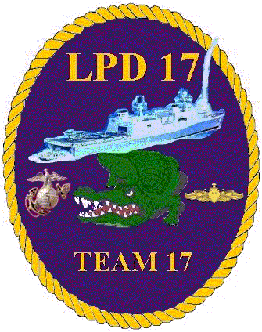
LPD 17 NAVY/MARINE CORPS WARFIGHTER AND SHIP DESIGNER IPT
CIC/TROOP OPS
WORKSHOP REPORT II
Table of Contents
..ii
I. EXECUTIVE SUMMARY
..1
II. INTRODUCTION
2
III. DISCUSSION
..3
IV. ISSUES
..13
V. ACTION
.16
A. WORKSHOP AGENDA
.A-1
B. POC LIST
.B-1
C. CIC/TROOP OPS FUNCTIONS
C-1
The workshop continued with focus groups identifying functions common to CIC and to Troop Ops/TACLOG - only one, command and decision making, appeared to require physical co-location of commanders and then the function only required physical proximity occasionally. With this in mind, NAVSEA representatives Mr. Donnelly and Mr. Douglas) developed a revised strawman space layout. The focus groups reconvened to review the draft design and to identify pertinent issues. Reformed, the members completed the workshop by refining issues pertinent to the revised arrangement. The PMS 317 Team plans to return in January 1998 to review drawings of options relative to space arrangement and to review planned C4I systems to meet space requirements. The following IPT actions resulted:
LPD 17 CIC and Troop Ops designs have progressed to the study drawing stage so a fleet/Marine review was considered necessary to create functional definitions for both spaces and to determine if the proposed system/space arrangements satisfy those functions with a particular interest in the value of collocation for some operations. Embodied by the Navy and Marine Corps Warfighter and Ship Designer IPT Charter, signed by N85, COMPHIBGRU TWO, COMPHIBGRU THREE, Deputy MARFORLANT and Deputy CG I MEF, the IPT met on 16-17 October 1997 at the LPD 17 War Room (EWTGLANT, Little Creek). The charter directed the IPT to:
Key IPT members included representatives from Commander
Amphibious Group Two, Commander Amphibious Group Three (COMPHIBRON SEVEN),
I. MEF/15th Communications Officer and G3, USS NASHVILLE, PCO
USS OAK HILL, COMSURFWARDEVGRU, SWOSCOLCOM, MCCDC, COMNAVSURFLANT, PEO
CLA, PMS 317, NSWC Dahlgren Division, and NAVSEA. The agenda and attendees
are provided at Appendices A and B.
Return To Table of Contents
III. DISCUSSION
Overview. RADM (Ret) Picotte, Team 17, welcomed
the IPT and provided overview and updates of the LPD 17 Program,
extending to the Design for Ownership (DFO) process. In addition, he presented
background information on Workshop I, briefed on pending action items from
that Workshop and presented unresolved LPD 17 Design For Ownership Data
Base Issues relevant to the IPT. He concluded by reinforcing the IPT Charter
credo that the "IPT will create concepts that will enable LPD 17 Combat
Information Center (CIC) and Troops Operations and Logistics Center (Troop
Ops) spaces to support a One Team, One Fight approach for executing
Naval Expeditionary Warfare missions, and enabling commanders to maintain
direct, sustained dialogue." Status of action items is presented in Table
1 and the unresolved data base issues are listed in Table 2.


Marine Corps Perspective. COL Quinlan of PEO CLA echoed the welcome and provided thoughts on the Marine Corps viewpoint of the space issues and the Warfighter and Ship Designer IPT. In addition to conveying additional background information and stressing the need to make LPD 17 "Warrior Friendly", he recommended that the IPT "think future" and remember "one team, one fight."
Design Discussion. Mr. Donnelly and Mr. Douglas followed with key attributes of the background, design considerations and potential paradigms involved in CIC, Troop Operations, and TACLOG. An interesting comparison was drawn between 21st century's LPD 17 and H.M.S. Dreadnought of 1905. Both ships reflect innovative design, technology leaps, enhanced combat systems, and holistic approaches to design. Highlights of the remainder of the presentation are as follows: a. Background. Originally, CIC was meant to be deep inside the ship, but survivability studies indicated that there was less vulnerability within the superstructure so it was moved to the 02 level. The modification to remove CIWS enabled the spaces to be moved up to the 03 level, promoting access to the Pilot House. Troop Operations was originally intended to be only a Tactical Logistics space, TACLOG. However, it was recognized that there were advantages to improving interconnectivity and command and control for embarked Marines or other forces. The space then adopted the dual role of Troop Operations and Logistics Center. When the space was raised to the 03 Level, another space, formerly a CIWS related space, became available outboard of Troop Ops and separated from TOLC by a bulkhead. A bulkhead with door access separated CIC from Troop Ops. 03 Level Configuration shown in Figure 1.
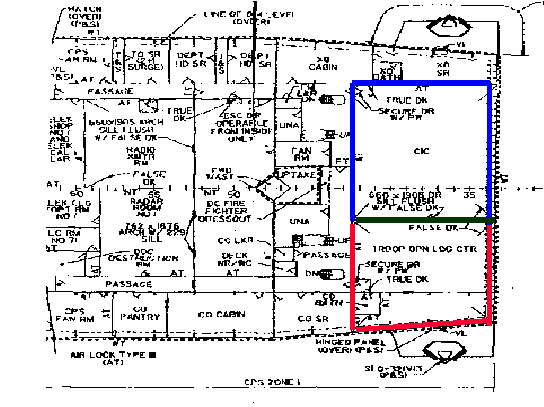
Key attributes of the spaces are listed as follows: (See Figure 2)
CIC - Organized into sensor, weapons, C2, and mission area
- JMCIS and ACDS available at command table
- Utilizes 2 or 3-man command table plus CO behind
- Large screen displays for overall situational awareness
Troop Ops - "Scaled down" Landing Force Operations Center
- JMCIS capable
-- Large screen displays
-- Same tactical picture as CIC
- Adjacent to CIC
- Shipboard Wide Area Network access to support USMC requirements
- IVCS and 23 TV provide voice connectivity and integrated video package to all operators, Navy and Marine.
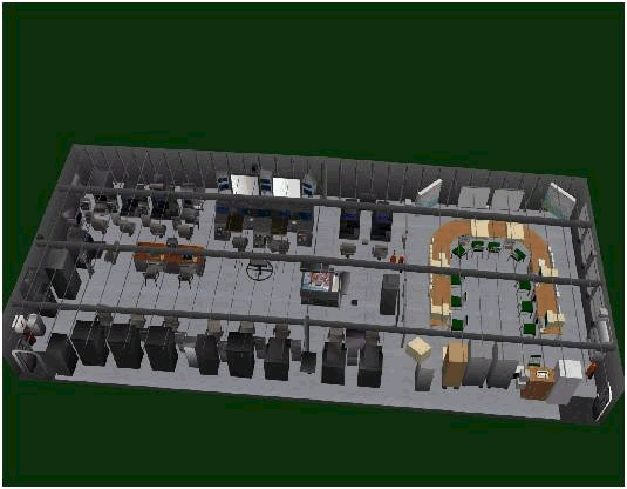
b. Concerns. During Workshop I the need for a bulkhead or the removal of a bulkhead (Figure 3) between CIC and Troops Ops was discussed and several concerns were raised:
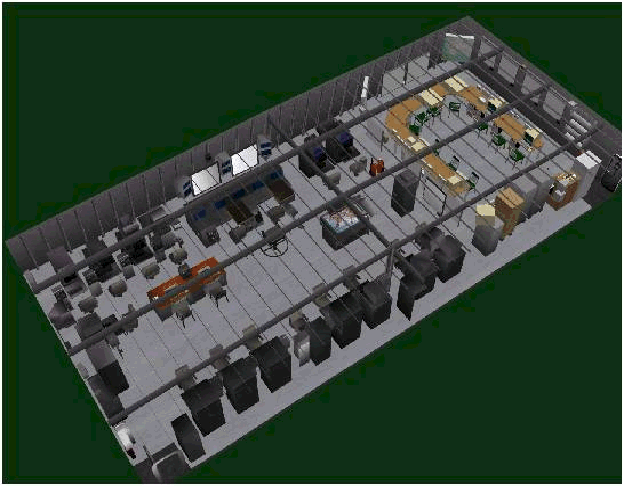
- Space configuration should not be thought of in conventional terms. Lighting differences between CIC and TACLOG today should not be a problem in the future as display boards and ASTABs replace grease pencils.
- Audio interference is probably a greater environmental challenge to sharing CIC and Troops Ops, but a paradigm shift in how we do business may be required. Noise management is of concern in any new arrangement.
- TACLOG should be closer to CIC air control - for information and status sharing. This might require part of TACLOG to be reoriented to be adjacent to CIC vice on the other side of Troop Ops.
- Marines require desk space in Troop Ops. Use a mission control type layout - Marines should be facing in the same direction, focused, and able to have face to face communications. "One team - one fight"
- Personnel sitting at consoles become focused on their task and greatly reduce ambient space noise.
- Ship to shore movement should be tied to Troop Ops
- There needs to be a single location where a Marine or embarked force commander may go to obtain a snapshot of what is happening from air, sea and ground operations to self defense.
c. Paradigms. With respect to these and potential concerns, the workshop briefer's
discussion referred to several related paradigms:
Light
Paradigm: CIC is a darkened space to facilitate vision of status boards and console.
Fact: CIC is not specified for low-level blue light - it is to be a low-level white light space and all displays must be clearly visible in that environment
Noise Level
Paradigm: CIC requires low noise levels and therefor should remain isolated from other shipboard functions
Fact: Reduced manning and improved station-to-station communications should reduce ambient noise levels within CIC.
Limited Access Space
Paradigm: CIC is a limited access space to protect classified information and to eliminate confusion in emergency situations
Fact: CIC can still be isolated for security or in emergency situations by closing the proposed SMART bulkhead between CIC and TOLC.
Separation of Functions
Paradigm: CIC and TOLC carry out different functions and should be separate spaces
Fact: During amphibious operations, CIC and TOLC provide mutual support in the planning and execution of the ship-to-shore movement.
Level of Activity
Paradigm: There needs to be a single location where a Marine or embarked force commander may go to obtain a snapshot of what is happening from air, sea and ground operations to self defense at any time
Fact: Equal information and situational awareness access
in TOLC will provide an accurate snapshot. In addition activity levels
vary. CIC maintains moderate to extreme levels during normal underway conditions
and special operations/ship-to-shore movements. TOLC has a very low activity
level increasing to extreme levels during later stages of workups and ship
to shore movements. A typical comparison is provided in Figure 4.
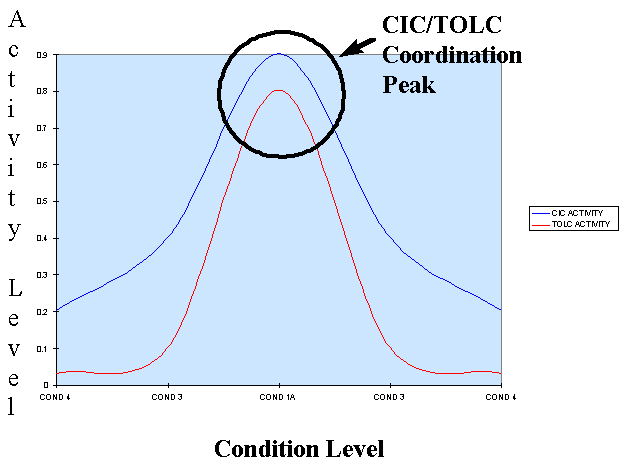
d. Workshop Process. After Workshop I, the signed IPT charter called for an initial meeting to prioritize space functions and a second meeting to develop concepts and pro and cons for various space design issues. In Workshop II these meeting were combined and objectives accomplished by the following process:

Based upon working group-identified functions, the IPT determined the following:
of the ship-to-shore movements (serial loads - what, when, where), monitors changes to
Operations, directs Landing Force Logistics, responds to Landing Force requests, and
coordinates with Primary Control Ship (PCS)
simultaneous (multiple cameras at the same time). Also want independent control of
external communications.
bulkhead such as is in place on USS CORONADO was recommended
Workshop Process continued:
First CIC and Troop Ops spaces were flip-flopped, CIC
moving to the starboard side on the 03 Level. Tracker alley, the track
and sensor management area of CIC was moved into the formerly unassigned
CIWS space to starboard of CIC (once a possible location for TACLOG). This
relocation would provide a secluded area for this function while still
remaining accessible from CIC. It was also the best use of this space given
the need to retain structural bulkheads.
Troop Ops and TACLOG would be integrated into a Troop Operations and Logistics Center, TOLC. However, a "smart bulkhead would be in place between the two spaces for separation depending upon mission requirement. TOLC = TACLOG + Troop Ops.
At the same time a "smart bulkhead" would separate CIC from TOLC for flexibility in future mission accomplishment. This would also allow direct access between TACLOG and the Primary Control function area of CIC as needed.
A Blue/Green Mission Planning space would be designed on the 02 or 03 levels to provide for direct side-by-side interaction during the critical planning and even execution phases.
Wrap-up. The workshop concluded with a review of outstanding issues and new issues raised during the course of the workshop. All action items from Workshop I were considered resolved. CDR Barbour of PMS 317 wrapped up the workshop by thanking the attendees for their forward thinking and willingness to accept change. He summarized the goals of the workshop and their accomplishment as follows:
The following issues were raised during the course of the workshop. Those resolved will be entered into the LPD 17 Design for Ownership Issues DataBase for historical documentation. Those requiring resolution or which will impact LPD 17 will also be entered into the LPD 17 Design for Ownership Issues DataBase for further action by the PMS 317 Ownership Team and/or the Configuration Change Board.
1. Debark Control and TACLOG should be co-located on LPD 17. Are windows required in
DEBARK? TACLOG functions necessitate its co-location with Troop Ops and adjacency to
CIC (Primary Control Functions) so co-location with Debark is neither desired nor required.
Windows were determined not to be required in Debark Control although television access is.
12. UAV connectivity and display is required for CIC, TOLC, JIC, and Mission Planning Center
13. There still exists a need for paper charts and hanging paper on walls.
14. Recommend investigating the feasibility of positioning DEBARK control as is done on the LSDs. With the CO in CIC for IA the XO will need to be located on the bridge so he would not be in Debark anyway. It will also facilitate access of information to all concerned.
15. Need to accommodate AFATDS functionality, What is the MAGTF C4I footprint for the LPD 17? MAGTF C4I equipment tends to be single mission/single function today, so for a multi-mission task, numerous systems will be needed. MAGTF C4I footprint will grow over the next few years until functions get merged in the same workstation.
16. What is the Special Warfare (JSOC/NSW) footprint and architecture? JSOC forces will come with unique radios/antenna and communication equipment. JSOC Forces will be aboard LPD 17 when it is the advance force ship.
17. What are the requirements for UUV/Remote Mine hunter/counter measures connectivity.
18. CIC/TOLC need independent control of lights, speakers, HVAC, etc. for each space.
19. An additional issue raised in this workshop addressed the need for antenna access for
portable radios brought onboard by embarked forces and providing a provision for them so as not to impact radar cross section considerations. Future growth in antenna access for possible additional radios should be included in planning.
20. Command and Control spaces on LPD 17 need the flexibility to be able to physically consolidate to meet mission requirements in the 21st century. Recommend "Smart Bulkheads", movable, collapsible bulkheads that are both sound and light insulated that were used in USS CORONADO's Joint Command Center, to separate TACLOG from CIC and Troop Ops and between CIC and TOLC.
21. The IPT supported the concept of consolidating the Combat Systems Maintenance Cental with Damage Control Central to form a single area for monitoring status and repair direction.
22. Recommend that the horseshoe table proposed for TROOP OPS (Figure 6) be dropped in favor of a table arrangement that faces a single direction.

The status of previously identified LPD 17 Data Base Issues
is recorded in Table 4.

PMS 317 will develop alternative approaches to the space arrangement discussed in Figure 5 along with corresponding C4I systems. These will be presented at a third workshop in January 1998.
16 October 1997
Welcome, LPD 17 Overview and Design for RADM (Ret) Picotte, Team 17
Ownership update
Marine Corps Perspective COL Quinlan, PEO CLA
LPD 17 Design Process, CIC/TROOP OPS Mr. Douglas, NAVSEA 03K412
Space Design Overview Mr. Donnelly, PMS 317/PEO TAD
Space Functional Definitions Focus Groups
Functions Review IPT
Strawman Design Presentation Mr. Donnelly, PMS 317/PEO TAD
Strawman Design Review Focus Groups
17 October 1997
Strawman Design Review Continued Focus Groups
Review Refinements and compare designs IPT
Address New and Outstanding Issues IPT
Summary and Wrap Up CDR Barbour, PMS 317
LPD 17 HOME PAGE http://lpd17.nswc.navy.mil
LPD 17/EWTGLANT Warroom: Phone 1-800-445-1916, Fax 757-464-8599
| Rank/Name | Command/Co. | Phone/fax/email |
| 1. MAJ Earl Cruse | NAVSEA(PMS317) | (703)418-2513 |
| 2. CAPT Tim Booth | NAVSEA(PMS317) | (507)437-3388 [email protected] |
| 3. LTCOL Larry Romaine | SURFLANT CFMO/CCO | (757)322-3150 Fax 3260 |
| 4. CWO 3 Larry Palmer | CPG-2 | (757)464-8289 Fax 8641 |
| 5. MAJ John Wasek | I. MEF/15th Comm O | (760)725-8859 DSN 365-8859 |
| 6. CAPT Carl Weiscopf | COMPHIBRON 7 COMPHIBGRU 3 REP | (619)556-5211 DSN 526 CPR7@ NOSC.NAVY |
| 7. COL Mike Quinlan | NAVSEA (OOM/PEO CLA(M)) | (703)602-6292 Fax 7150 [email protected] |
| 8. RADM Picotte USN(Ret) | ASC | (757)424-3711 Fax (757)420-6910 |
| 9. William J. Donnelly | PEO(TAD) | (504)437-3539 [email protected] |
| 10. MAJ Dan McGuninness | 1 MEF G3 | DSN 365-6266 [email protected] |
| 11. Larry Johnson | LOGICON/SYSCON(LPD-17) | (703)553-7822/7837 [email protected] |
| 12. Fred Elks | LOGICON/SYSCON(LPD-17) | (703)553-7850 [email protected] |
| 13. Billy Douglas | NAVSEA 03K412 | (703)602-7345X418 FAX (703)602-3723 [email protected] |
| 14. CDR Steve Joachim | PCO USS Oak Hill Rep for CPG-2 | (757)464-8855 |
| 15. CAPT Craig P Lambert | COMNAVSURFLANT N635M | (757)322-3292 [email protected] |
| 16. LT COL Tom Harleman | COMSURFWARDEVGRU USMC LNO/N73 | (757)363-4984 [email protected] |
| 17. CDR Ernest Bartley | COMSURFWARDEVGRU N7 | (757)363-4984 [email protected] |
| 18. LT(USN) Lori Muscleman | COMSURFWARDEVGRU N7 | (757)363-4984 [email protected] |
| 19. MAJ Tom Hartshorne | MCCDC.Quantico | DSN 278-6193 |
| 20. Ben Raterman | NSWCDD | (540)653-2886/2290 [email protected] |
| 21. Dennis Warne | NSWCDD T05 | (540)653-2291/2290 [email protected] |
| 22. Jon Sweigart | NSWCDD | (540)653-3675 [email protected] |
| 23. Bill Heidt | COMPHIBGRU TWO | (757)464-8874/8711 |
| 24. OSC Byrd | USS Nashville | |
| 25. LCDR Merv Dial | SWOS, Newport, RI | (401)841-4962/3 [email protected] |
| 26. Stan Brown | TRW | (703)685-6747/8913 [email protected] |
| 27. LCDR Jim Henry | COMPHIBGRU TWO | (757)464-8195/363-4986 [email protected] |
| 27. Kendall King | ASC | (757)424-3711 Fax (757)420-6910 |
| 28. Wink Campbell | ASC | (757)464-8604 Fax (757)464-8599 |
CIC (Combat Information Center): Functions common with Troop Ops are bolded.
ARG/TF level - external multi-platform
Communications External (SHF, EHF, UHF, HF, VTC, VHF, etc.)
Primary/Advisory Control (LCAC, AAAV, LCU, etc.), Landing Plan execution
(OTH Ops - LCACs are on their own, not directly controlled by Mother ship)
9. C2W Command and Control Warfare for C4I
10. Tactical Maneuvering and coordination with other Ships/Units
11. Equipment Configuration Control (CSRO)
12. Command (Decision Making) - flexible to support varying activity and able to surge
13. Logistics and Resupply (UNREP/VERTREP)
14. SAR - Search and Rescue
15. Mission Planning and Execution
16. Internal coordination control (DEBARK Control, local Air Control) vs. External/ARG Control (PCS, LCAC control, Breach Force Commander, Advance Force Ship, etc.)